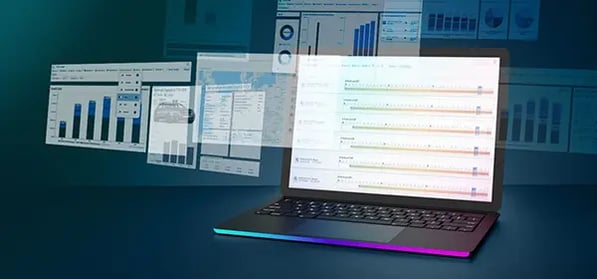Strategic Planning
IN FOCUS
Strategic Planning & Sales Management
5 advantages of the right digitization and the secret to success, that automotive managers should know

- Resources
- Publications
- Strategic Planning & Sales Management
INTRO
Why at all?
Profitable growth only succeeds with systematic planning and effective sales steering
How fast do we want to grow in which business areas? Where do we want to intentionally withdraw? How fast will we grow at all if we continue as before? How do we ensure that the sales department implements the plan? What are the consequences of the latest customer information? And what does this mean for our capacity and financial planning? These are questions that all companies - and of course automotive suppliers as well - have to ask themselves and which, as a consequence, require strategic decisions.
The dynamics of change in the market and the half-life of planning have been experienced by automotive suppliers in recent years and demonstrate the need for a planning and control system that continuously provides up-to-date information. Ideally, this information should be automated and processed in a way that is suitable for management, so that data-based decision-making becomes a reality.

"Sales Planning must serve the goal of being able to make well-founded strategic decisions - not just once a year."
Erik Reiter
25 years Automotive Supplier-Management (Sales -> CEO); Sales Consultant for Strategy and Processes; Co-Founder Digital Automotive
The current state of strategic sales planning and sales steering at automotive suppliers has potential
Today, strategic sales planning at most automotive suppliers is characterized as a laborious, manually time-consuming, weeks-long, error-prone and rigid process that takes place once a year. In addition, sales steering derived from this process only takes place in exceptional cases.
The reason: Sales today does not yet have the right tools to perform this enormously important task in a meaningful way.
Limitations of current solutions for strategic sales planning and steering
-
ERP systems are not made for sales planning and steering
ERP systems such as SAP are strongly focused on finance, production, logistics or HR functionalities. The needs of the sales department, at least of the automotive supplier sales department, are not or only insufficiently mapped. Future-oriented growth planning, future volumes or future price influences (changes, claims, etc.) are not mapped. The planning of strategic target projects also does not take place there.
-
Excel is problematic for data from many sources and complex workflows
The limitations of Excel in handling these huge amounts of data from different sources, error-proneness, missing processes and lack of integration capability are widely known. Therefore, Excel is (unfortunately) not suitable for holistic growth planning and sales management. To get it right: Excel is an outstanding program, which was designed for a different purpose, and was used in the field of growth planning for lack of previous alternatives.
-
CRM is unsuitable for automotive suppliers with project business
Some automotive suppliers are trying to find a way out in CRM solutions. Here, too, the list of failed attempts is unfortunately long. Why? Because CRM programs were developed for a completely different business environment. In other industries, these programs are perfectly suited to organize sales and also planning. For automotive suppliers with their multi-year projects, complex product structures, thousands of part numbers, multi-layered changes (changes, claims) in prices and quantities, these solutions unfortunately do not work.
In one sentence: a system like CRM which is fully focused on contacts cannot work satisfying for projects.
Besides, the systems are expensive and the automotive supplier pays for functions (marketing campaigns, CMS, pipelines, etc.) that do not exist in its business.
As a result, data that is already out of date the day after it is submitted, cannot be used as a basis for making decisions about the strategic direction of the company - neither in the short nor in the long term. If, in addition, the system does not allow for easy adaptability, the sense and benefit is quickly lost.
And this despite the fact that strategic planning is supposed to serve "to ensure the survivability of the company and to achieve the company's goals". To have the right decision-making basis for this, you need a system that is transparent, efficient and effective. And these must not just be good-sounding buzzwords.
Right digitization - made for sales planning and steering of automotive suppliers - has enormous advantages, 5 of which are shown here:
ADVANTAGE 1
Consistency in one system
More transparency and efficiency through stringent planning and control: From market observation to strategic planning, acquisition to booked business
In a well-functioning system of strategic planning and sales management, projects move smoothly from one status to the next, so that the entire life cycle is covered. There are no more system discontinuities. Sales and volume developments always include the past and a look into the future for the next few years, both for booked and strategically planned business.
Upstream data sources (e.g. ERP systems that provide past volumes) must be able to be integrated seamlessly. Processes that have a direct influence on price developments (change, claim) and volume forecasts are ideally already available in the planning and sales control system.
Only the complete coverage of the life cycle from market observation to strategy and (successful) acquisition to booked business at project/product level allows professional planning and control. The aggregations based on this in all relevant dimensions (customers, regions, product groups, plants) create the necessary insights to make the right decisions.
ADVANTAGE 2
Forecasts and decisions in real-time
If you want to react and act quickly, you need decision-making bases that are continuously updated - without ad-hoc effort and time delay
No one has to summarize or prepare anything. The basis for decision-making is easily available at any time at the push of a button. In automatically generated reports suitable for management. In our highly dynamic times, characterized by continuous change, this must be the requirement for modern corporate steering.
The daily new information on sales, prices, volumes, changes in strategic target projects, acquisition results must be available and updated at any time. No matter whether for the past or the future - even beyond the delivery schedule.
Only those who have access to this information in real time can draw the right conclusions for capacity adjustments, claiming and the adjustment of their strategic orientation in a timely manner.
ADVANTAGE 3
Flexibly customizable strategic goals and scenarios for booked business
If you want to create a target-oriented basis for decision-making, you need flexibility in the planning system in order to be able to visualize the effects of possible decisions and market influences.
In order to comply with the strategic and financial guard rails, the adjustment of the strategic target projects is a key influencing variable. It must be possible to add or remove target projects quickly and flexibly in a planning system in order to make the effects immediately visible.
The strategic planning process is based on a large number of assumptions. The volatility of the market environment, especially in the automotive supplier industry, requires thinking in scenarios. Different assumptions for prices and unit sales are the key levers. For the entire company, specific customers, products, regions or individual projects. All this has to be simple and fast so that the basis for decision-making is there when you need it.
Data-based decisions can only be made by those who have created the right structure
-
Structure for each lifecycle phase so that everything fits together
Laborious and error-prone copying together of unstructured sales plans of individual business units from different sources, possibly even in Excel, should be a thing of the past today.
What is needed as an automotive supplier is a system in which all project and product businesses can be integrated efficiently and in a structured manner for each phase of the life cycle:- Booked business: Necessary data is automatically transferred from ERP systems
- Acquisition: Data is automatically transferred from existing (digitized) processes
- Strategically planned business: Data is automatically transferred from the existing (digitized) processes
- Booked business: Necessary data is automatically transferred from ERP systems
-
Standardization of project and product names
Business and project names should be standardized throughout the life cycle to enable meaningful evaluations. For project business, a link with IHS (S&P Mobility) data is ideally suited here. This ensures a standardized program code already at project creation years before SOP up to EOP.
-
Categorization (segmentation of the market)
Meaningful categories (segments) that are needed later for evaluations must be rolled out systematically across the organization. The most important example categories for automotive suppliers are:
- Customers
- Regions
- Plants
- Products
- Platforms
- Customers
-
AI also needs structured data
Anyone who assumes that AI will carry out strategic planning completely automatically in the future is laying the foundation with the right structure so that this will be possible at all. Unstructured data stored on decentralized hard drives in Excel also make it impossible for AI to generate meaningful recommendations for action.
ADVANTAGE 4
Management-ready reports for successful STEERING
In order for reports to become the center of decision-making and steering, it is not only the content that is important
"Anyone who says today that it doesn't matter what reports look like hasn't observed automotive management."
Of course, the content is important: the right charts and top KPI's to quickly get the necessary insights. However, it should not be underestimated how management's attention depends on the visual design of the reports. And if the goal is for top management to independently access the latest reports in the evening or at the airport instead of their favorite app, it's essential to emphasize design and ease of use.
Different perspectives for different purposes
Standardized, automotive-specific reports (charts and other visualizations) help management to quickly understand the context and draw the right conclusions. The most important reports that should be standard for the strategic planning and sales management of an automotive supplier today are:
- Growth charts
- Portfolio views
- Target project overviews
- Potential target overview (target cars and engines)
- Life cycle views of cars/engines
Filters for the right segmentation
These different perspectives are significantly enhanced by filters that segment the specific report according to requirements. The standard filters by which automotive suppliers segment their business are: Customers, Regions, Plants, Products, Projects, Platforms. Of course, these filters must be able to be combined with each other in any way so that the automotive manager gets the right insights.
Reports are no longer created manually, these are generated automatically
Reports for steering and also performance measurement (how well is the planned strategy being implemented?) are now generated fully automatically on the basis of system data to be integrated or as a "by-product" of digital processes. These digital processes used to take place in stand-alone and rarely standardized Excel spreadsheets. Today, these processes are part of an overall sales management system.
ADVANTAGE 5
The implementation is also supported digitally
Operationalization and visualization of planning is the precondition for success
The key steering element for automotive suppliers with project business are the strategically planned target projects: The products that are to go into specific cars to fill locations or penetrate new markets. These are the basis for planning and must be translated into concrete acquisition projects so that strategic planning becomes reality.
For automotive suppliers with product business, it is analogous to define the planned new business as concretely as possible in order to track its implementation.
"Visualizing goals for more commitment."
A promising approach is to visualize these goals in a digital planning and steering system so that they can be viewed by every manager in the company at any time.
The focus should always be on contracts that are due to be awarded in the next 12 months. On this basis, management can initiate concrete actions to increase the probability of winning the business.
From strategic sales planning directly to the acquisition process
In an integrated digital system, the acquisition process is linked to the strategic process. The strategically planned projects are lifted directly to the next status, naturally including the transfer of existing data. Perfectly realized, what is needed is a multi-stage, versionable process tailored to the needs of automotive suppliers. The result: a management summary with all decision-relevant information - prepared for digital signature. So that nothing stands in the way of winning the order and thus implementing the growth strategy.
Linking the planning with the individual target agreement
Another measure to create commitment is to link the operationalized targets with the individual target agreement.
Ideally, all of this takes place in an overall digital system in which the target agreement and review process is also fully automated.
Transparency on the results achieved
Success in strategic planning is measured by the order intake of the planned target projects. If the planned orders are won, the growth targets in the respective markets are also achieved. In an integrated digital system, the acquisition process is directly linked to the strategy process. Here, too, the process delivers the result in the form of reports as a by-product in a fully automated manner. The status of the projects moves from "Strategy" to "Acquisition" and finally "Business booked".
By the way: automotive suppliers should definitely "claim" in case of quantity deviations compared to the contract status. But this is another important topic that also exists in a digital solution.
THE KEY TO SUCCESS
AUTOMOTIVE-SUPPLIER-specific, expert digitization
Only those who create a system in which all the requirements of automotive suppliers can be mapped will achieve the breakthrough
The automotive supplier industry has very complex dimensions when it comes to meeting all the requirements for strategic corporate planning and control. To understand the complexity that needs to be thought through, here is an excerpt of what modern software solutions need to offer:
-
Project and product business
-
OEM and tier business
-
High-level (business unit, project level) vs. part number level
-
Standardized project/ and product designations
-
Project setups for multiple vehicles (grouped only or as "one" project)
-
Pricing and cost information including different CBD and costing schemes
-
Link to IHS (S&P Mobility) and other market data sources
-
Material price surcharges
-
Different volume levels: Planning, budget, IHS (S&P), contract level
-
Price changes for the future (influences from reductions, claims, changes etc.)
-
Investments and direct reimbursements
-
and many more
In addition to the realization of these requirements, it is of course important to realize the 5 advantages described above. Furthermore, it should be considered that a holistic system of sales management does not only include the functionalities mentioned here, but also the claim and change management process, as well as the price and one-time cost management (tools, development costs, quicksavings, etc.).
Only a standardized industry solution for automotive suppliers can meet the requirements
Implementing the very specific requirements of automotive suppliers for strategic planning and sales management requires real expert knowledge. If you want to act professionally here, you need a solution developed by industry insiders. When the bundled knowledge of a large number of automotive suppliers is combined in a single software solution, the result is something valuable for all users.
The industry standard that has implemented the requirements described and the resulting benefits is Digital Automotive. The result for the automotive supplier: profitable growth!
CONCLUSION
-
Strategic planning and sales management for automotive suppliers is a complex and multi-layered process that can now be implemented completely digitally.
- The results of the right way of digitization are:
- Consistency in one system
-
Real-time forecasting and decision making
-
Flexible adjustment of strategic goals and scenarios for booked business
-
Management-ready reports
-
Successful implementation
- Functionalities for holistic sales management that go beyond growth planning: Change, claim, price, and one-time payment management.
-
All the aspects and requirements mentioned have been successfully implemented in the leading industry standard Digital Automotive by automotive suppliers for automotive suppliers.
Experience the Next RFQs and SOPs Powered by Digital Automotive?
In over 25 years of automotive supplier sales management, we have learned the benefits of digitization. Discover an improved process experience with Digital Automotive. We are happy to share our expert knowledge with you.


